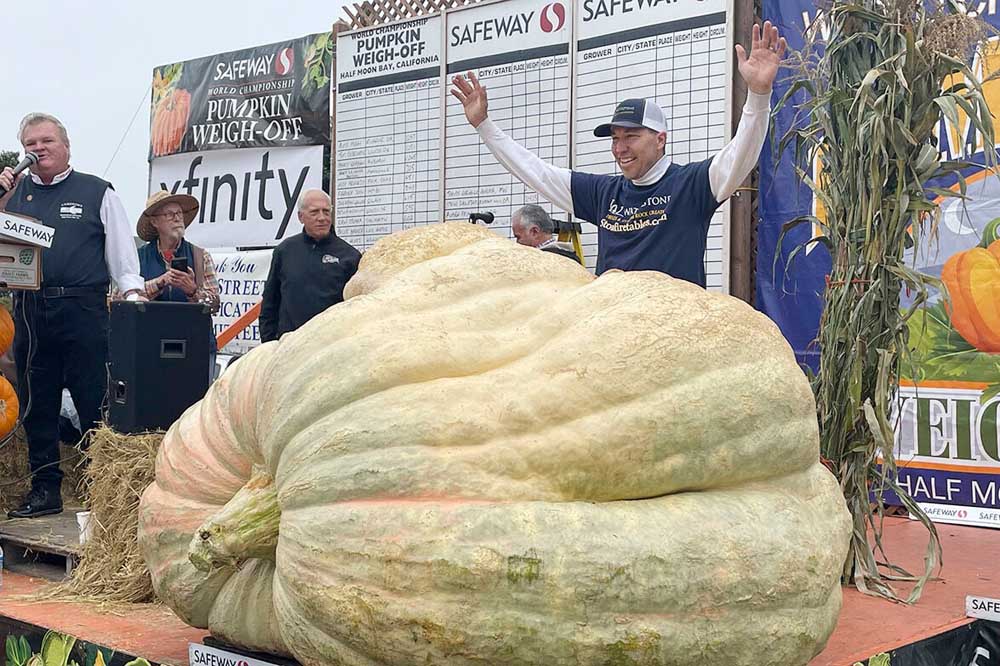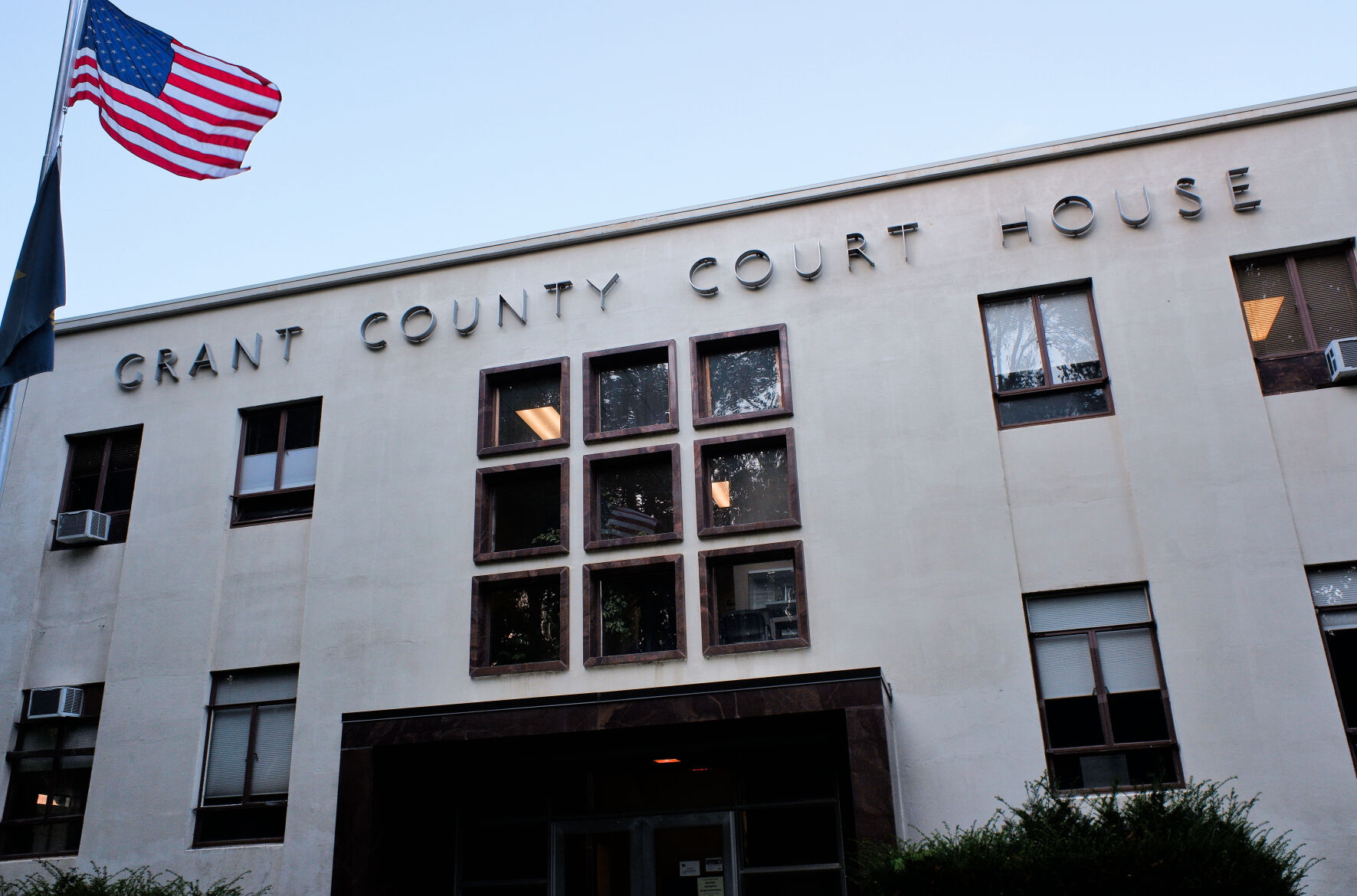Giant pumpkin breeding makes enormous progress
Published 7:00 am Thursday, October 27, 2022

- Travis Gienger from Anoka, Minn., stands behind his winning 2,560-pound pumpkin at the 49th World Championship Pumpkin Weigh-Off in Half Moon Bay, California, on Oct. 10.
Despite their grotesquely bloated appearance — or perhaps because of it — giant pumpkins are known to evoke a curious reaction: love at first sight.
Growers of the oversize gourds commonly recall feeling a relentless, magnetic fascination upon discovering them at an autumn fair or festival.
“I was just captivated by these giant pumpkins. I made a note that if I ever had a property with enough space, I’d try to grow them,” said Brian Williams, treasurer of the Pacific Giant Vegetable Growers nonprofit.
“It was just the enormity of them,” he explained.
A decade ago, Williams tore out a paved sports court at his home in Lake Oswego to make room for the garden where he now grows enormous vegetables.
He’s since been amending the “terrible” soil with organic matter, and while he still cultivates giant pumpkins, Williams now specializes in long gourds that top 10 feet in length.
Competition is stiff among the 120 members of the organization, who strive to produce the heaviest or longest specimen in eight crop categories, but it’s surpassed by the spirit of camaraderie.
“We’re all a bit dorky and I think we take comfort that we can dork out with other dorks of the same variety,” said Williams, who works as a consultant on occupational safety and health regulations.
Though giant pumpkin growers tend not to take themselves too seriously, they’ve nonetheless performed astounding feats of agronomic and genetic improvement in recent decades.
Good breeding
At more than 2,500 pounds, the world’s heaviest pumpkin weighs twice as much as the record-holder 20 years ago and three times as much as the standard-bearer 30 years ago.
“As a group, we understand so much more about the science and what you need to let them grow big,” said Russ Pugh, chair of PGVG’s seed committee in Eugene, and an events promoter.
Selective breeding has propelled this massive progress, with enthusiasts planting seeds from past champions and fertilizing the flowers of those plants with pollen from other promising offspring.
These lineages are tracked as earnestly by giant pumpkin breeders as those of thoroughbred horses or champion livestock.
“There are family trees that go back for generations,” Pugh said. “Serious growers won’t grow them unless the genetics are known.”
What makes these accomplishments all the more impressive is that most giant pumpkin growers aren’t professional farmers, but come from a variety of professional backgrounds, said Brett Cooper, a founding member of PGVG who grew giant pumpkin seeds commercially for about two decades.
The ‘obsession’
Since the 1980s, the market for giant pumpkin seeds has grown from several hundred people to tens of thousands around the world, said Cooper, who lives near Forest Grove.
For growers, the “obsession” is driven partly by the plant’s unbelievable growth during the height of summer — in the time it takes to eat a sandwich, it’s possible to measure minute changes in size, he said.
“When I started growing, you wanted a pumpkin that grows 15-20 pounds a day,” he said. “Now they can grow 50-60 pounds every single day.”
From the perspective of breeding, however, it’s not enough to select for pumpkins that rapidly get heavy.
In the past, pumpkins that simply packed on pounds without greater durability were easily damaged, often disqualifying them from competition.
“They’d collapse under their own weight,” Pugh said.
Traits that confer thick walls and flexibility are critical, so the fruit — yes, a pumpkin is a fruit — can withstand its own weight and environmental stressors.
3,000-pound holy grail
To grow a pumpkin weighing more than 3,000 pounds, the hobby’s current holy grail, breeders will also need to prolong the pumpkin’s prime growing period, Cooper said.
Currently, the fruit grows at an optimum level about 30 days, which should be extended to 40-45 days to hit the 3,000-pound goal, he said. “It’s not going to be long until we get there. We’re almost there now.”
Genetics are often freely exchanged in the giant pumpkin world, with growers sharing pollen and cooperating on breeding.
No secrets
Each year, seeds from the top contestants are auctioned off to support the PGVG’s weigh-off events, and new members get a seed packet when they join the club.
“It’s one of the key perks of membership,” said Kendall Spielman, its president and a forklift mechanic.
Tips about horticultural practices are readily disseminated among growers as well, an effect of the internet era, Pugh said.
Whereas people would once gain insights from a book, the rate of innovation now moves too fast for traditional publishing, he said.
Growers now largely educate themselves online and are willing to tell their peers about successful methods to advance the hobby, Pugh said.
“Twenty years ago, if someone had a secret, it stayed a secret because they thought it gave them an edge. With how the world is now, there’s no such thing as a secret,” he said. “The digital age has really changed things.”
Of course, the hobby is hardly devoid of rivalry, but growers say it’s good-natured and furthers the noble aim of producing ridiculously large pumpkins.
“We’re competitive with each other and we’re competitive with ourselves, if we’re talking about our personal best,” Spielman said.
How it’s done
One of the main constraints on growing giant pumpkins is space.
At least 1,000 square feet are needed to produce a single “world class” pumpkin worthy of competition at the highest levels, Williams said.
Growers must be careful to remove all but the sole female flower that’s meant to be pollinated, so all the vine’s energy is focused on the resulting pumpkin, he said.
“That’s the golden rule. To maximize that growth, you just want one fruit per plant,” he said.
Sprinkling mycorrhizal fungi into the soil helps the plant better absorb water and nutrients, Pugh said. Vigor is further enhanced by burying portions of the vine so additional roots grow from the nodes.
“Instead of one root, you get hundreds of roots,” he said.
Another limiting factor is common to all agricultural pursuits — the weather. The earlier the vine is established and the fruit is fertilized, the more time the pumpkin has to attain an incredible size.
Rain and low temperatures can diminish that growth opportunity, as occurred this spring, which has compelled some growers to install greenhouses.
“If the weather doesn’t cooperate, you can manipulate the environment,” Pugh said, adding that such investments can become expensive. “There are people who spend a lot of money, no question about it.”
Other competitions
Those who lack the capacity to maximally fatten pumpkins have other ways to shine among aficionados.
For example, Williams doesn’t have enough room in his garden to grow colossal pumpkins, but he’s still managed to make a name for himself with long gourds.
The vegetable grows suspended from trellises, allowing him to be a leading contender in the category despite the confined dimensions of his garden.
Gary Kristensen found another way to overcome the tight parameters of his yard in Happy Valley.
Instead of worrying about size, he’s been selecting for vibrant color to stand out in competitions based on visual appeal.
“I don’t have the space or the skill to be the biggest, so I grow as orange of a pumpkin as I can,” said Kristensen, a real estate appraiser.
Compact pumpkins have also helped Kristensen dominate the yearly West Coast Giant Pumpkin Regatta, during which the gourds are rowed around a man-made lake in Tualatin.
He’s consistently won that race precisely because his pumpkins aren’t too immense.
“Don’t grow too big of a pumpkin,” he said. “Grow it just big enough to float you but not to sink you.”
Halloween celebrations
Giant pumpkins have become an integral part of the annual Halloween celebrations at Bauman Farms near Gervais, which kicks off its autumn festival with a weigh-off.
More than $21,000 in prizes were awarded at this year’s weigh-off, including $5,000 for the largest pumpkin. Such contests operate according to rules set by the Giant Pumpkin Commonwealth, the hobby’s international governing organization.
The competitors have won the respect of Brian Bauman, the farm’s general manager, though he has a less indulgent approach to plant care.
Commercial farmers aim to keep entire fields of crops healthy and uniform while minimizing unnecessary inputs. Giant pumpkin growers, on the other hand, pamper each fruit on an individual basis.
“It’s hard. It’s really hard,” said Bauman, who’s also tried cultivating giant pumpkins. “They’re out there covering it up at night with blankets to keep it warm. You spend days and nights with these puppies to make it happen.”
Though they’re more coddled than most crops, giant pumpkins provide an entertaining connection to farming, much like corn mazes and other agritourism activities, he said. “It’s an extension of the joy of agriculture. It’s really a great fit.”
Their improbable ability to keep getting bigger offers a lesson about defeating self-imposed obstacles as well, Pugh said. Rather than assume their achievement has peaked, growers keep setting their sights higher.
“One thing we’ve learned is don’t put limitations on it. Once you put limitations on it, that’s what it’s limited to,” he said. “One of the things that limits us in life is what we believe is possible.”









